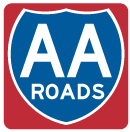Historic U.S. 66


The Colorado Street Pioneer Bridge, which carries Historic U.S. 66 and Colorado Boulevard over the Arroyo Seco in Pasadena. Built in 1913, this 1,486 foot long bridge still makes a statement today with its bold concrete arches and sheer height. - 12/10/2005
Historic U.S. 66 (also known as Route 66, the Mother Road, Will Rogers Highway, and National Trails Highway) is perhaps the most famous highway in the United States. Traversing eight states on its trip from Santa Monica to Chicago (through California, Arizona, New Mexico, Texas, Oklahoma, Kansas, Missouri, and Illinois), Historic U.S. 66 passes through many towns that time forgot. Relegated to business loop or frontage road status for much of its route nationally, the last segment of U.S. 66 was bypassed by freeway in 1985 in Arizona. The entire route was decommissioned shortly thereafter, and now U.S. 66 is signed as an historic route. Signs are erected all along the various routings of U.S. 66 in the Los Angeles metropolitan area and Inland Empire, and U.S. 66 is well-signed on its extant sections between Cajon Pass, Barstow, and Needles.
Historic U.S. 66 California Guides
- U.S. 66 East
- U.S. 66 West
- California 66
- California 2
- Business Loop I-15 and Historic U.S. 66-91 - Victorville
- Business Loop I-15 and Historic U.S. 66-91 - Barstow
A portion of this route is still state maintained, even though portions of the route are being remanded to local control. Currently, however, California 66 is Foothill Boulevard between California 210 in San Dimas/Claremont and Interstate 215 in San Bernardino. California 66 matches the original routing of Historic U.S. 66 for its entire length. This highway is much more often signed as either Historic U.S. 66 (brown shields) or even as U.S. 66, even though U.S. 66 is long since decommissioned.
The longest extant sections of Historic U.S. 66 are located in San Bernardino County. On November 4, 2011, signs were erected along the National Trails Highway between Victorville and Barstow and from Barstow to Needles designating Historic U.S. 66 as San Bernardino County 66, complete with blue and gold pentagon markers. These signs were installed at the request of County Supervisor Brad Mitzelfelt after he had observed similar route marker signs on county highways in other states and other parts of California.1 A dedication ceremony for the county route followed on November 11, 2011.
Located at the north end of Amboy Road west of Amboy is this directional sign for Historic U.S. 66 east to Amboy and Needles and Historic U.S. 66 west to Ludlow and Barstow. Someone added "Vegas," since the best route to Las Vegas from here is to take old U.S. 66 east to Kelbaker Road north through Mojave National Preserve to Interstate 15.
04/01/07
Historic U.S. 66 passes by Amboy School, Roy's Motel and Cafe, and the Amboy Post Office in the unincorporated community of Amboy, a minimally populated town in the Mojave Desert.
04/01/07
The Roadrunner's Retreat is a former gas station and restaurant in the Mojave Desert along the south side of Historic U.S. 66.
03/14/09
The Colorado Street Pioneer Bridge is one of the most remarkable bridges along Historic U.S. 66.
12/10/05
Located along Colorado Boulevard between Downtown Pasadena and Eagle Rock, the Colorado Street Pioneer Bridge opened to traffic in 1913.
12/10/05
An even older bridge spans the Arroyo Seco below the Colorado Street Pioneer Bridge in Pasadena.
12/10/05
Linda Vista Avenue passes under the Colorado Street Pioneer Bridge in Pasadena north en route to the Rose Bowl. Linda Vista Avenue north from Colorado Street was historically part of California 11 and later California 159, which was removed from the state highway system in 1989.
01/28/06
The Colorado Street Pioneer Bridge was historically part of U.S. 66 Alternate between Figueroa Street and Arroyo Parkway. State Route 11 overlapped with U.S. 66 Alternate west and south from Linda Vista Avenue as well.
01/28/06
At the east end of the Colorado Street Pioneer Bridge is this plaque memorializing the 80-year anniversary of the bridge in 1993. Dedicated on December 13, 1913, the bridge was designed by DeLeuw, Cather & Co. from San Francisco and was built by Kiewit Pacific Co. from Santa Fe Springs.
01/28/06
The Santa Monica Pier entrance is located off Ocean Boulevard and Colorado Avenue. Despite the fact that U.S. 66 never officially ended at the pier, popular media has made the pier the sentimental western terminus of U.S. 66. An "End of Route 66" sign is posted on the pier next to a memorabilia store.
10/30/05
The actual end of U.S. 66 was at the intersection of Olympic Boulevard and Lincoln Boulevard, near the west end of Interstate 10 (Santa Monica Freeway). Below the bridge connecting Colorado Avenue to Santa Monica Pier is California 1 (Pacific Coast Highway).
04/21/07
A small kiosk selling Route 66 memorabilia is located next to the End of Trail marker at the end of the driveable section of the pier.
11/11/09
On the side of the 66-to-Cali souvenir shop is a replica End Historic Route U.S. 66 sign. U.S. 66 was commissioned in 1926.
11/11/09
Cars are allowed to drive onto Santa Monica Pier to a parking area near the 66-to-Cali souvenir shop.
11/11/09
Toward the back of Santa Monica Pier are various amusement park rides which are part of Pacific Park.
11/11/09
Santa Monica Pier
04/21/07
The Palisades rise above the sandy beach next to the Pacific Coast Highway.
04/21/07
The Pacific Ocean, Santa Monica Mountains, and Palisades all come into view from the Santa Monica Pier.
11/11/09
References:
- New SB County Route 66 signs are in!, by Brad Mitzelfelt, San Bernardino County's First District Supervisor from 2007-2012, dated November 4, 2011. http://joinbrad.com/blog/?p=2548
Photo Credits:
- Andy Field: 10/30/05, 12/10/05, 01/28/06, 04/01/07, 04/21/07, 03/14/09, 11/11/09
Connect with:
Page Updated Saturday January 12, 2013.



















